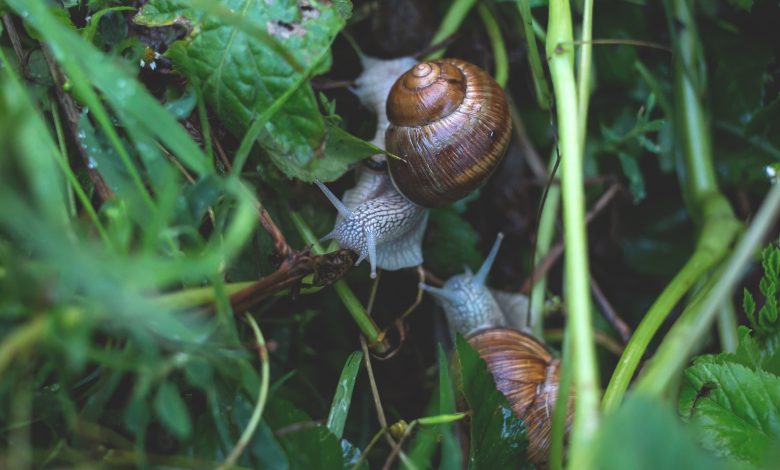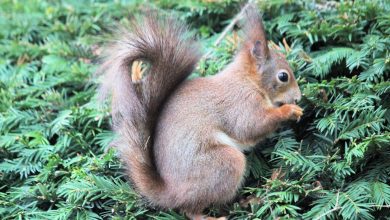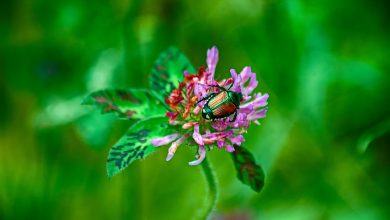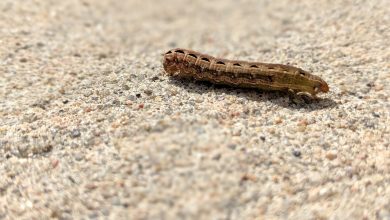How to Keep Slugs and Snails Out of Your Garden

A few snails or slugs in your yard isn’t a cause for alarm; in fact, it’s a good thing – at least until you notice that you’re hosting large numbers, and you’re seeing the signs of sticky trails all over your garden.
Slugs and snails are similar, but they do have some differences that are worth noting. If you’re trying to get rid of an infestation in your garden, consider the following information that will help you lower their numbers and keep them under control.
Slugs
The term slug refers to any shell-less, gastropod mollusk. Even though almost all slugs look similar in their physical form, they are all a part of very different evolutionary lineages. This means that, although they may look alike, many slugs are not even related.
The slug is built with two pairs of tentacles on its head, also referred to as feelers. The lower pair works to provide a sense of smell, while the upper pair works to provide a sense of light. This pair also has eyespots at the ends of the tentacles.
The bottom portion of the slug is referred to as the foot. This part of the slug’s body operates by creating rhythmic contractions and simultaneously secreting mucus that protects the foot from damage. This allows the slug to propel forward in a single motion.
The slug has two kinds of mucus: One is watery, and the other is thick and sticky. The thin layer spread from the center of the foot to the edges, while the thick layer moves from the front of the body to the back.
You might recognize you have a slug problem based on numerous sticky trail that have been left behind. Predators use this trail to chase down slugs, but the mucus can also serve to make the slugs too slippery for predators like birds.
Slug Reproduction
Slugs are hermaphrodites, which means that they possess both male and female organs. As a result, they can procreate without having to wait for a particular partner. This is one of the reasons that snails can pose such a problem if they are arriving in your garden in droves.
A single slug can lay anywhere between 30-40 eggs in a cycle, and they will reproduce three or four times every year. Slug eggs do not take that long to hatch, so you could be part of an infestation before you know it.

What Do Slugs Eat?
Most garden slugs aren’t very picky, but it really depends on the species. Since it takes them so long to get where they’re going, they’re likely to munch on other things as they make their way through your garden.
Some species of the slugs are more particular than others, with a few breeds being referred to as fungivores.
Fungivores are more likely to search for slime molds and various types of mushrooms, such as the oyster mushroom and the penny bun. In some cases, various species will even be picky about the development stage of the fungi they’re eating.
A couple of slugs aren’t a huge deal for your garden; however, if a good number of them start to work on any specific plant, they can cause all kinds of destruction.
While slugs are happy to eat most of the things they find in your garden, there are some items that they prefer more than others.
Leaves
Slugs will be very interested in any new plants that have arrived in your garden, especially if they’re just coming out of their seedling stage. That’s because the leaves on these plants are soft and chewy, which makes them a favorite to the slug.
Young and tender plants will not last long if a slug has found them. They will eat both the leaves and the stems, and a few slugs can make light work of your hard-earned seedlings.
Dead Debris
Even though they love fresh, new plant life, slugs are also attracted to dead matter. If you have debris lying around the yard that has yet to be cleaned up, there is a good chance some slugs have already made their way to it.
Additionally, slugs won’t be picky when it comes to dead insects, birds, and other animals. As these items decompose, the slugs will become a sort of clean-up crew. Although it’s not nice to think about, slugs do help with the healthy decomposition of other organisms, and they’re a key part of many ecosystems.
Slugs
Some slugs will actually eat other slugs, whether they’re alive or dead. The leopard slug is one of the key predators in the slug family who will eat other slugs when necessary.
If you’re struggling with your slug populations, you can always introduce a couple of Leopard Slugs to the garden to try and clean up the rest.
Ethylene
For some reason, slugs are very attracted to something called ethylene. It is a chemical – one that is often released by ripened fruit.
That being said, slugs can almost always find ripe fruit trees and bushes, and they will happily gorge on all of your hard-earned harvests. Fruits they are especially interested in include apples, grapes, cherries, strawberries, and raspberries.
If you know that you are going to be planting a fruit tree, always keep in mind that these plants will certainly attract a number of pests, not just slugs.

How to Prevent Slugs
It’s hard to tell if you’re going to have a slug problem unless you’ve experienced it before. To avoid dealing with these garden pests, there are some preventative measures you can take.
Plant Things They Don’t Like
One of the best ways to deter slugs from your garden is to plant things that they aren’t interested in eating. This includes the following plants:
- Geraniums
- Fuchsia
- Oriental poppies
- Figwort
- Oyster plant
Similarly, slugs don’t like the smell of strong herbs, so you can incorporate these as well:
- Onion
- Thyme
- Lavender
- Rosemary
- Chives
If you’ve got slugs feasting on a specific area, plant these herbs amongst the other plants. This will help to block the aromas that the slugs like and will instead overpower them with smells they detest.
Introduce Slug Predators
Slugs will make a nice snack for all kinds of animals, so you might consider introducing a few of them to your yard if they’re not already present. A variety of vertebrates and invertebrates will be happy to help you with your infestation.
Toads and frogs love to feast on slugs, but they aren’t always easy to entice to your garden. If you are planning on incorporating a water element into your garden, you might have better luck bringing these predators to the area.
Beetles and worms are also interested in slugs for a meal, but you don’t want to invite too many of them to the space. For a nice balance, add a log pile or a pile of stones to the back area of your yard. These will offer small crevices where these creatures will hide out during the day. Of course, these kinds of structures will entice other unwanted pests to make homes in the fall and winter, so be sure to get rid of them before that happens.
Birds are another common predator of slug, and they are a welcome addition to any garden. Consider adding a few bird feeders to your space, as well as some houses or bird baths. If you can entice birds to visit your area more frequently, they will help with any slug issues and may also help to keep down the number of grubs, cutworms, etc.
How to Get Rid of Slugs
Beer Trap
As mentioned, slugs are attracted to the smell of ethylene, which is found in fruits. However, this chemical is also found in beer, which makes the alcoholic beverage another item that slugs cannot resist.
To get rid of the slugs in your garden, you can grab a bottle that only has a small amount of beer left and create a trap for the slugs. They will either drown in the beer, or you can consistently check the bottle and dispose of any slugs in and around the area.
Rock Salt
Slugs can only survive if they are constantly lubricated. Without their protective slime layer, they become exposed to the elements and can’t travel as well.
This is where rock salt can become your friend. The salt will be difficult for the slugs to travel over, and it will essentially dry them out. Although it is not the most humane option, it will most certainly do the trick.
Try to lay some salt down on a dry day so that the rain doesn’t wash the salt into the soil as much. If you’re happy with the result you’ve had in a day, consider scooping up as much of the salt as you can when you’re finished. This will help to protect the soil from too much salt intake.
Nematodes
Nematodes are microscopic worms that are sure to help with your slug problem. The nematodes will work their way down into the soil, where slugs will often eat them without realizing the danger they pose.
The nematodes will then slowly consume the slug from the inside out and continue to eat the corpse of the slug as it breaks down. The worms then lay eggs in the corpse and establish themselves further into the soil.
Nematodes are pet and child-safe, and your food will still be safe to consume as well. If you’re going to take this route, use some water to help them work their way deep into the soil.
It may take some time for these worms to establish a front line of defense, but if your garden has long struggled with slugs, it will be well worth it.

Snails
The most basic definition of a snail is a shelled gastropod. The term is used for most species in the Gastropoda class, which have coiled shells that are big enough for the creature to fully curl into.
When using the term snail, you can be referring to land snails, freshwater snails, and also sea snails. Humans have quite a relationship with this creature, sometimes keeping them as pets, using their shells as jewelry, and including them in high-end culinary dishes.
In terms of their cultural significance, we often associate patience and slowness with snails. We are very aware of these creatures, but they are not quite as warmly-welcomed when they are infiltrating our gardens and crops.
Snails can be found all over the world and in a diverse range of places, including deserts, oceans, and the tropics. We are more familiar with land snails, but sea snails actually boast the greatest number of different species.
Some snails have lungs, and others have gills, but the animal has evolved so much over time that it is normal to see a land snail with gills and a sea snail with lungs.
Snail Reproduction
The reproductive system in snails is located near the head, which is called the genital pore. Snails each mature at different times though, and reaching maturity can happen in the first few weeks or could take up to five years. The surrounding environment usually has something to do with the speed of a snail’s sexual maturity.
Some snails are hermaphrodites, but there are still breeds that exist which possess only male sexual organs, or female sexual organs.
Snails in the family Pomatiidae are unique because they are either female or male, with no in-between. It is simple to tell the males and females apart because the size of the male shell is much smaller in size.
Similarly, some freshwater snails have only one gender, including apple snails and periwinkles.
If your garden is home to snail eggs, you’ll be able to find them within the top layer of soil. Typically, two snails will bury their collection of eggs in the same hole, separate from the other. The snails will be looking for soil that is cool and moist and will avoid areas that are too dry or hot.
Eggs develop in two to four weeks, and they will begin looking for food as soon as they are born. Since their shell is so soft, they will immediately need to start gaining strength and adding calcium to their diet. They will eat their own eggshells, and sometimes those that have not hatched.
What Do Snails Eat?
Land snails are typically herbivorous, meaning they will focus their efforts on finding plants and grasses. Similar to slugs, there are some snails that are carnivorous, but this is not a typical practice.
Most garden snails are interested in your vegetation, and they will happily mow down on fruits and vegetables. They also have a taste for thick leaf plants, as well as flowers. If you have any berry bushes or a vegetable garden, though, it’s likely that this is where they will want to be.
In some cases, snails will also eat dead plants and debris. If you only have a few snails in your garden, these creatures can be very helpful for breaking down matter and helping with decomposition. However, too many can wipe out your garden in a short time.
How to Prevent Snails
If you have a snail or slug infestation, there is good news: If you’re working to prevent one of them, you’re likely going to be preventing the other species too.
These creatures are very similar, and they can both be a huge pain when they have a big appetite. The best thing you can do is to keep a close eye on your plants and take action as soon as you notice any leaves or stems that have chew marks or holes.
If you’re worried about snail infestations because of previous experience, preventative measures can help to ensure the snails don’t return next year.
Electric Wire
An electric wire will give snails a small zap, and it will shock them enough to keep them away from the area. Some gardeners line their garden beds with an electric wire, which can easily be stapled in place.
Any snail that makes its way up the side of the garden bed will feel the zap and quickly move in the opposite direction. Take care to only use this method if you don’t have children or pets in the area.
Keep Your Garden Clean
As mentioned, snails like to hang out in damp, shaded areas. That being said, if you’ve got a garden that hasn’t been properly manicured, you’re leaving all kinds of comfortable snail spots exposed.
It is important to keep your grass cut and for any yard debris to be cleared up right away. Your compost should also be kept in a protected location since this is the perfect spot for a snail to come and lay their eggs.
Before the winter comes, be sure to give your yard another good clean so pests aren’t coming along to lay eggs or overwinter.
Water in the Morning
Snails are nocturnal, which means they only come out to chomp on your plants at nighttime. If you water before dark, you’re only creating a more perfect oasis for them overnight.
To avoid this, make sure that you do most of your watering in the morning. This way your plants get the moisture they need, but it will all be gone before evening falls.
Hand Pick
If you have noticed a handful of snails in your garden, you might be in luck to prevent a worse scenario. Head out into your garden when it’s dark out and use a flashlight to find the few snails that have shown up.
Check under leaves and in the top layer of soil. You can get rid of these creatures manually and avoid giving them time to lay eggs.
A few snails and slugs are great for your yard, but too many can be devastating to your garden.

How to Get Rid of Snails
If you’ve already noticed a spike in your garden snails, here are some tactics to lower their numbers.
Introduce Snail Predators
If your garden is snake-friendly, then you will have a serious predator to hunt down your snail infestation. We’re not talking large snakes, merely small garter snakes that will slither through your garden beds and snatch up any snails that are caught on the ground.
There are many other predators of the snail, including birds, lizards, cats, and other snails.
Decollate snails are carnivorous, and they will happily feast on your garden snails. You can incorporate a few into the space and let them do their thing. The good thing is, these snails won’t harm any of your plants.
Gritty Substances
Naturally, snails prefer a smooth surface to make traveling easier. If your garden soil is gritty and uncomfortable, especially around their favorite foods, they will likely avoid them.
Diatomaceous earth is one of the best options for creating an uncomfortable surface for snails. It is made up of sharp fossil pieces, and any snail that moves over it will not make it back out. This is an eco-friendly option that will likely halt any other pests that are trying to eat your plants.
If you don’t have diatomaceous earth, you might consider adding some broken eggshells around your most prized plants. Keep in mind though, that your soil will respond to these eggshells and begin trying to break them down. As a result, the beneficial microorganisms in your soil will turn their attention to the eggshells, and away from your plants. Try to use the eggshells for as short a time as possible to avoid your plants losing that attention.
Snail Trap
Snails love dark, damp places, and they won’t be able to resist a perfectly good resting spot that’s wet. You can trap snails by creating your own little oasis for them, which you can later remove and dispose of with the visiting snails.
Try to use an object that will hold the water or stay moist, like a piece of folded cardboard or a dampened cloth. Be careful when you go to collect this trap – it may have other pests inside as well, such as earwigs.


